Turtles, Geese and Ducks: A Pond Adventure
Red-Eared Slider, Copley Pond Park, New York, USA

Image credit: agmoore
This photogenic turtle was swimming near the shore in a small neighborhood pond recently. The turtle convivially shared the water with other pond creatures, including Canada geese and Mallard ducks. One thing that struck me as I watched the peaceful scene, was how well these different species tolerated each other. For example, here's a picture of the geese swimming past a turtle. This turtle will become a central character in my blog today.
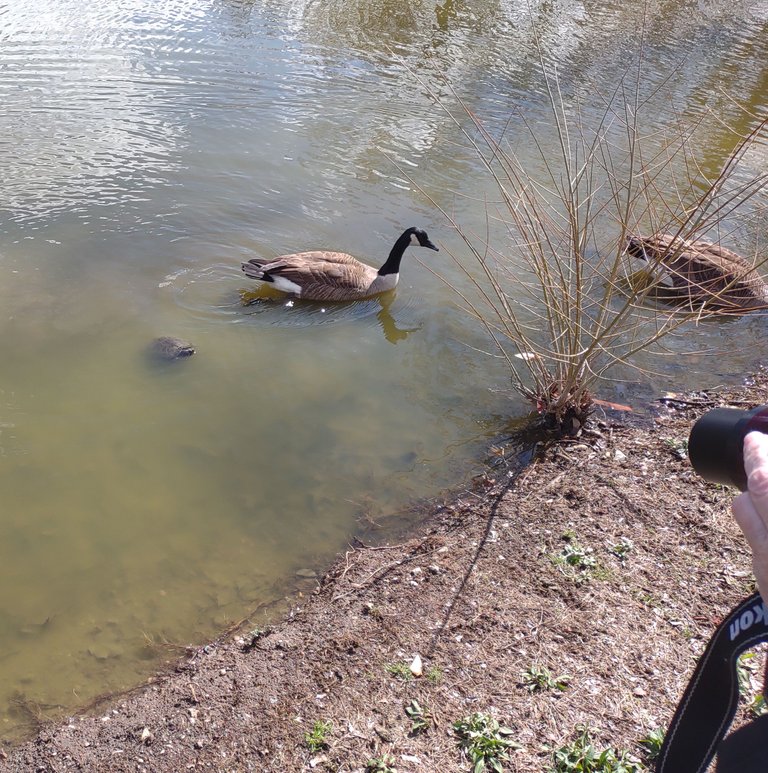
Image credit: My husband snapped this shot with his cell phone. That's my hand and my camera in the frame.
And then there were the ducks. Here is a picture of them contentedly swimming behind a goose.
Ducks at Copley Pond Part, New York
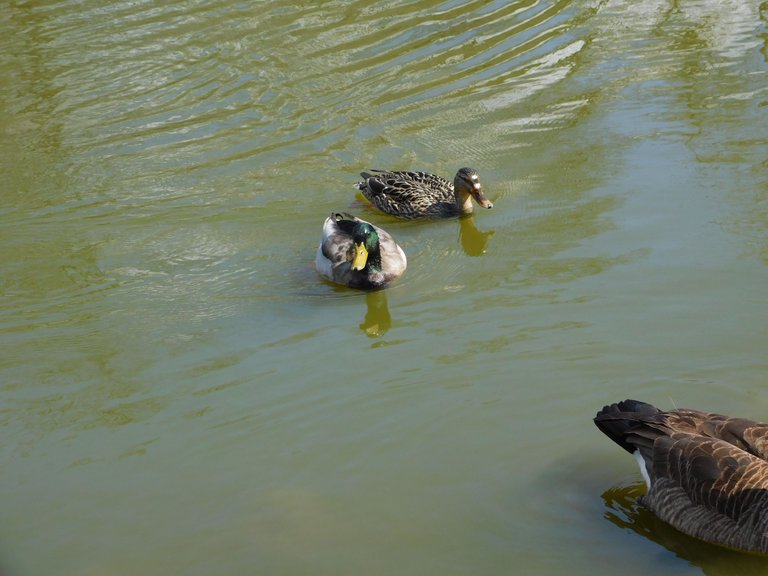
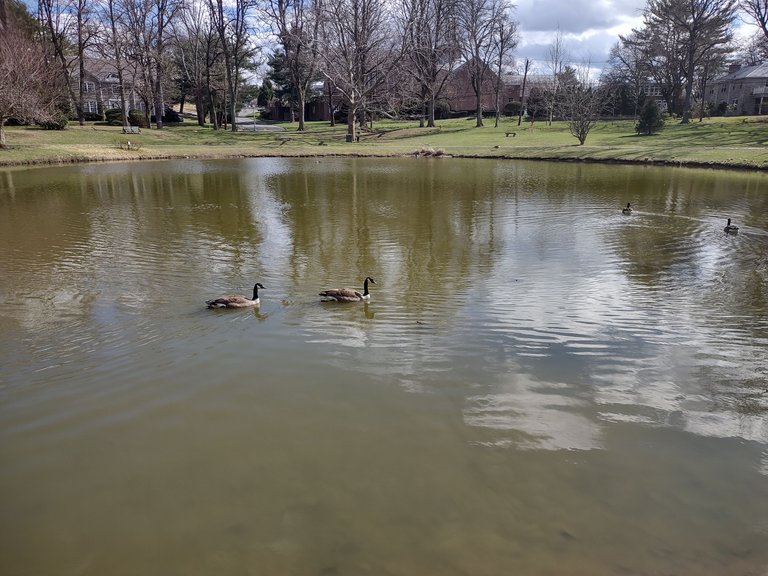
As I watched the three animal species use the resource of the pond harmoniously, I recalled all those nature videos I'd seen of watering holes where prey animals tried to get a sip as predators picked off a few of the most vulnerable in their midst.
I wondered about the pond as an ecosystem. In a way, the pond, the turtles, the geese and the ducks were all characters in the natural drama that was playing out before my eyes. Why do the geese, the turtles and the ducks find the pond a congenial place to hang out?
Each of these characters played a distinct role so I tried to learn about each one and how each animal came to be there for me to enjoy on that afternoon.
It turns out the only one that actually would be there without human intervention (anthropogenic action) was the duck.
Canada Geese (Branta Canadensis) Introduced
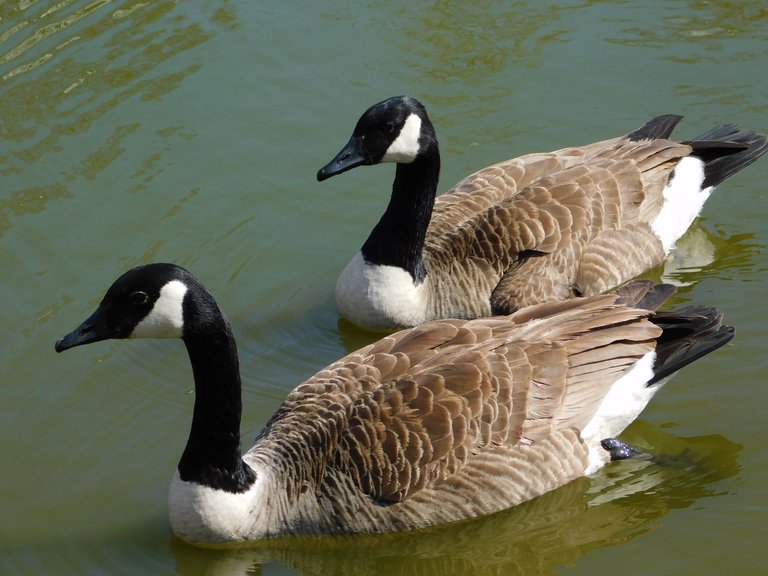
Credit: agmoore
The geese were Canada geese. This species was introduced into New York in the early 1900s. They were originally owned by private individuals who lived near the Hudson River. The geese were released into the wild and proliferated. Today, (although I love to look at them) they are considered an invasive species. However, they are protected by law. There is a goose hunting season that lasts thirty days and limits the number of geese killed to one per day. Beyond that, people are not allowed to injure a goose, although they may harass it.
Today it is estimated that there are about 200,000 resident Canada geese in New York State. Additionally, there are hundreds of thousands of migratory birds that return seasonally. The problem between humans and geese arises because of the bird's preferred nesting environment. They like flat areas abundant in fertilized grass, within reach of water. This preference places them on lawns, golf courses and even grassy mounds in parking lots. While the geese may be beautiful, they produce prodigious amounts of excrement--about two pounds a day. This excrement production is what makes them unwelcome guests in many areas.
The Red-Eared Slider (Trachemys Scripta Elegans)
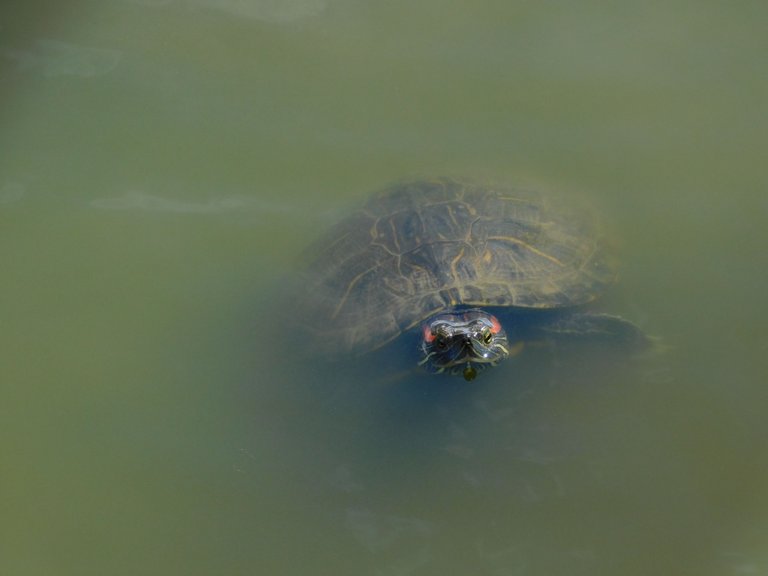
Image credit: agmoore
The turtle in my picture looks a lot like a native species, the painted turtle, but the slider is actually invasive. As is true with the goose, humans released these animals into the wild. First purchased as pets, the red-eared slider became a tiresome addition to many households. They live a long time (20 years in captivity and up to 70 in the wild), are prolific producers of excrement, and spread disease.
The slider is a hardy species and survives in just about any environment. Once released into the wild, they proliferated. They are larger and more aggressive than the native painted turtle. The red-eared slider wins out in a competition for space, and resources (especially food). In the pond I visited, this was the only species I saw. (Technically, red-eared sliders are terrapins, which means they spend time in the water and on land).
All amphibians in New York are covered by law, which means there are regulations about releasing them into the wild (don't!) and regulations that cover injuring them. They may be killed, but only by a vet through humane euthanasia.
The Mallard Duck (Anas Platyrhynchos)
(Picture snapped at a neighboring pond: Female in the front)
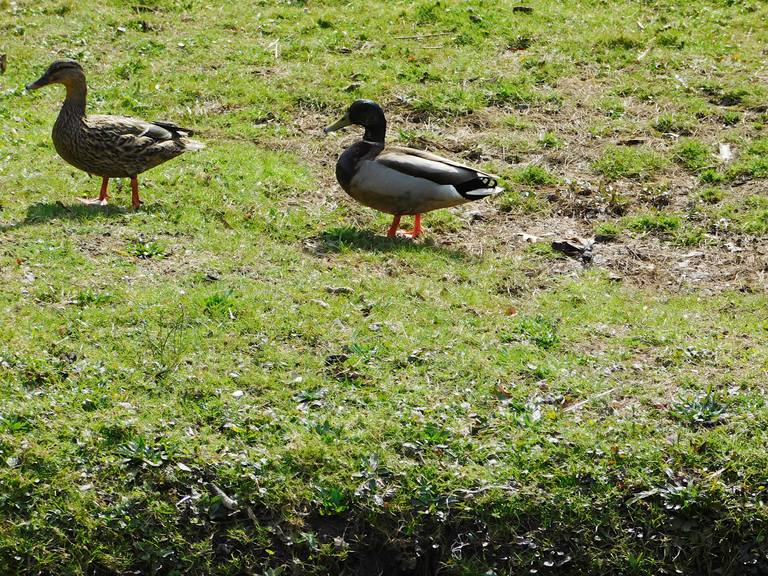
Image credit: agmoore
According to the Cornell Lab at Cornell University, the Mallard duck is the “most widespread abundant duck” in North America, and may be found abundantly in many parts of the world. Because the Mallard successfully breeds with other species, most varieties of duck in North America are descended from this species. Although the Mallard might have made its way to the neighborhood pond without human intervention, the species is still affected by human action.
The Mallard is the most popularly hunted duck in North America. It also has become habituated to humans in some areas, especially in locales where humans might offer them food (such as parks).
Copley Pond
(The goose is taking note of the turtle in this picture)
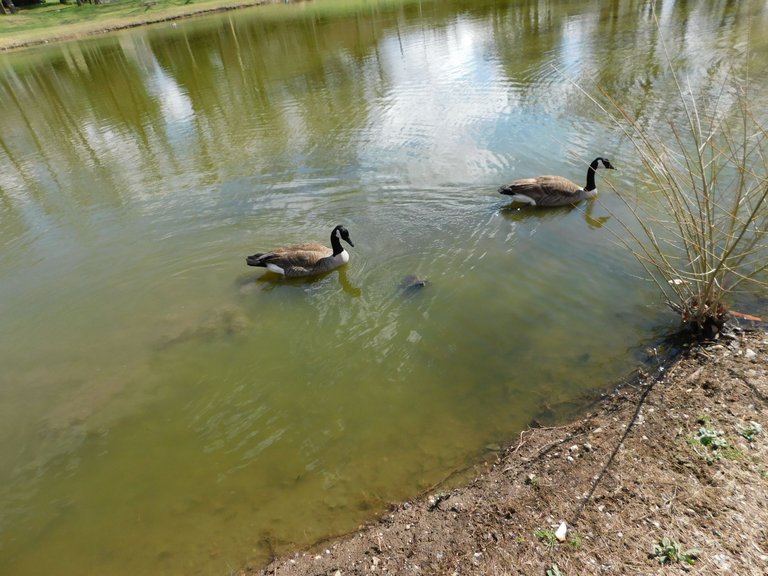
It would be hard to say whether this pond would have existed without human intervention. Long Island is so highly developed that water tables are profoundly affected. The US Geological Survey in 2018 issued a report on the effect of development and water use on streams, ponds and lakes on Long Island. Long Island is an island (although, in 1985 the US Supreme Court defied geography and ruled that legally, it was a peninsula). We have ponds, lakes and streams that pop up all over the island. This is the case with Copley Pond, although the pond is so small I have not been able to find an article that addresses the issue. Ponds that pop up and are fed by an underlying water source are called table ponds. Ponds that exist because of seasonal precipitation are called vernal ponds. It seems pretty certain, given the geography of Long Island, that Copley is a table pond.
As I walked around the pond, there were signs of life everywhere. It's spring, a time of renewal. Renewal, for our three featured animals in this blog, means nesting and breeding. Copley Pond offers not only a congenial place for our animal friends to hang out. It also provides an ideal nesting/breeding area. All three animals reproduce sexually, but maternal care of the young varies significantly. In each case, though, nesting occurs within reach of water.
Canada Geese
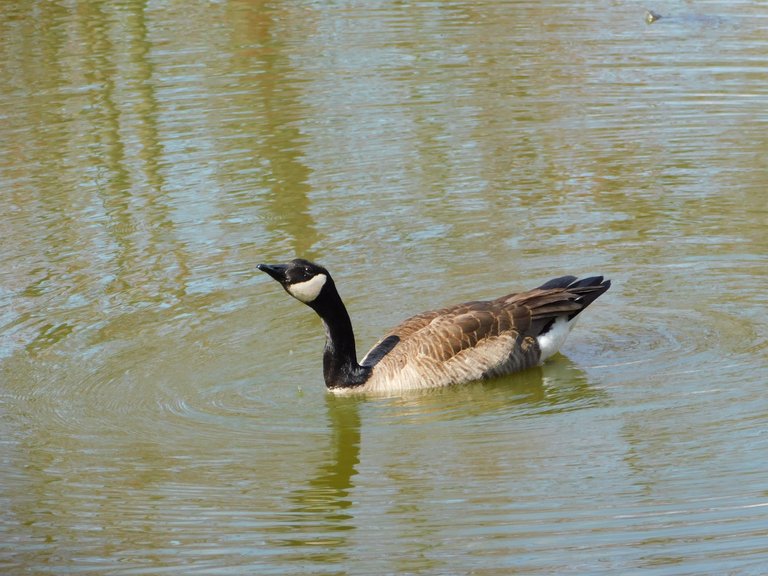
Image credit: agmoore
Canada geese mate for life. It has been reported that if one of the pair dies, the other will mourn. The mourning may go on for a very long time, especially in older geese. Egg laying takes place (on Long Island) perhaps in April. The female builds a nest on high ground, usually within reach of water. She lays eggs once a year, on average. Hatching occurs about a month later.
The Canada goose is a devoted mother. She will not eat or leave her nest during incubation. She lays an average of five eggs a year. The father is aggressively protective of his family, and both parents are ferociously protective of their young.
Red-Eared Slider

Image credit: agmoore
The red-eared slider is a solitary creature. It is born alone and lives alone. It finds a mate in spring, when the male inseminates the female. Courtship occurs under water, and the male can be quite aggressive. A female may be inseminated by more than one male. Therefore, the offspring from her clutch may have several fathers.
The eggs are not fertilized during mating, but during the egg laying process. The female holds onto the sperm until that time. Once the female has made her nest and deposited her eggs, her job is done. The young hatch in adult form (although of course they are smaller). They must survive on their own. Preparation for egg laying takes place close to water, but because the slider is an amniote, there has to be a terrestrial nest. Eggs are deposited in a shallow hole (which the turtle has excavated), within about 600 feet of the water.
Ambient temperature determines the gender (genotypic sex determination). Colder temperatures (71.6°-80.6 ° F) result in male offspring. Warmer temperatures yield female offspring.
Mallard Duck
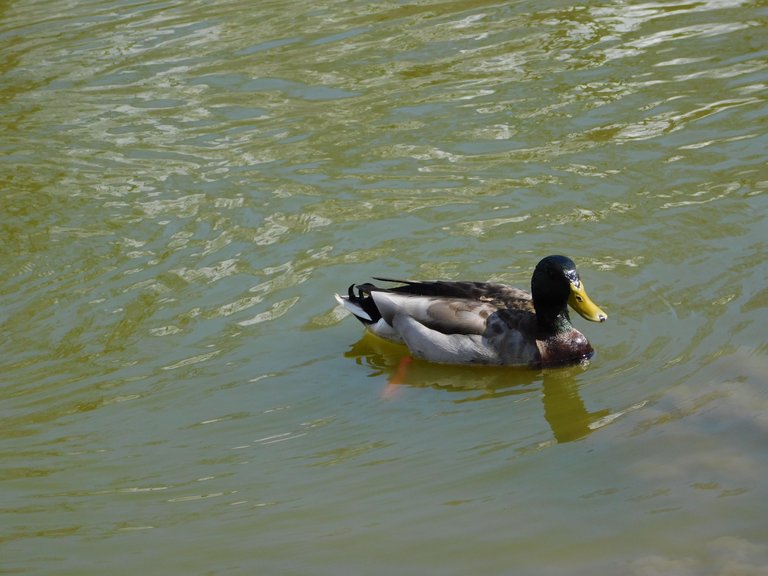
Image credit: agmoore
According to the Royal Society for the Protection of Birds Mallards generally choose a nesting site near water. The nest will be covered by vegetation or, the ducks may find a hole in a tree in which to make a nest.
The ducks pair up in fall or winter, after the male courts with a mating display. The female chooses her mate. Male and female find an appropriate nesting site together. The male stays with the female until she lays her eggs. Then he abandons her to care for the eggs and ducklings on her own. After the eggs hatch the mother takes them to water almost immediately. They remain with their mother for fifty or sixty days, until they can fly.
The Pond
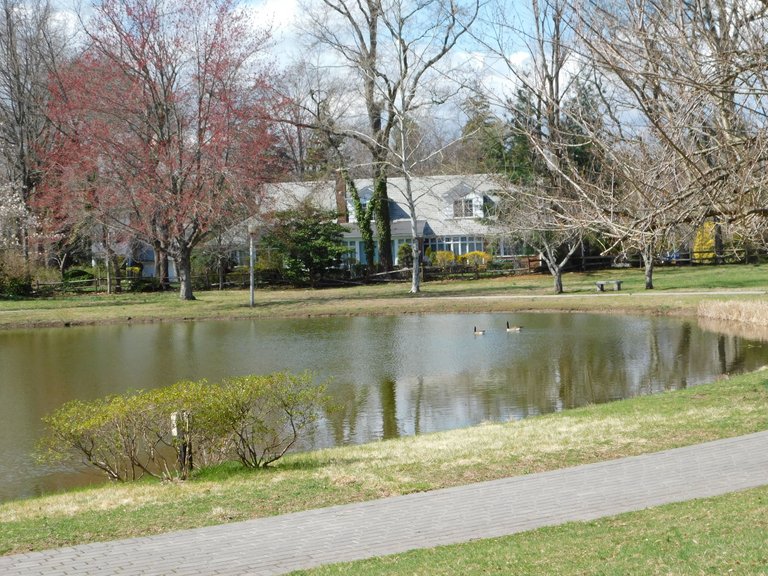
Image credit: agmoore
We know already, from the information above, how the pond helps the Mallard, the Canada goose, and the red-eared slider. It gives them a place to rest, to breed and to eat. Do the animals do anything for the pond? It seems they do.
The Canada Goose: According the Rutgers University Cooperative Extension, despite their reputation as bad neighbors, there are ecological advantages to having Canada geese around. Through all their prodigious poop, they spread seeds and help plants to grow in new areas. And, their poop actually is good for the soil (in moderation). It adds nutrients. Finally (and sadly) they are part of the food chain. Other animals, such as raccoons, foxes, snakes, and turtles feed off their eggs, and even the geese themselves.
Red-Eared Slider
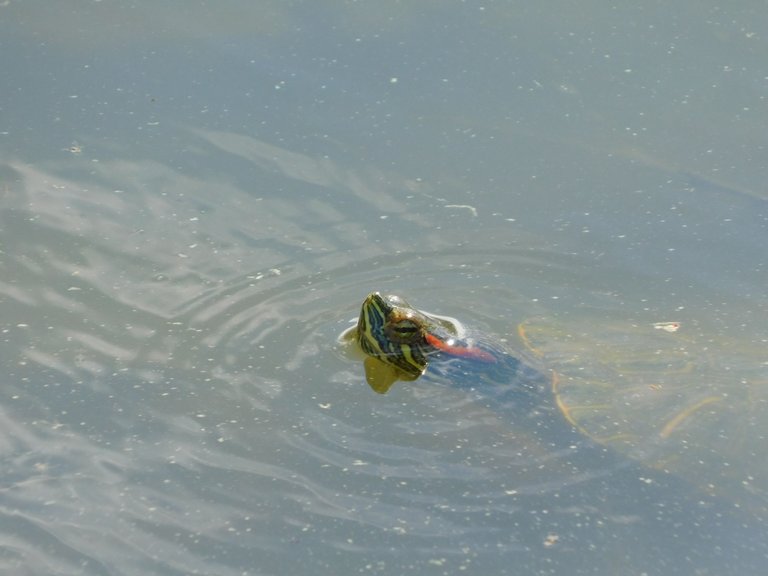
Image credit: agmoore
According to the website Magnolia Fisheries, red-eared-sliders are good for pond ecology. While some fishermen resent their presence because turtles eat fish, according to this website, any fish that is slow enough to be caught by a turtle is too sick for consumption. The turtle is doing us a favor by eating it. Because of their fondness for carrion and debris (sliders will eat anything) they help to keep the pond clean. The red-eared slider also helps to cut down on excess pond vegetation, and algae.
Mallard Duck
While ducks have sometimes been faulted for soiling areas with their poop, generally ducks are good for a pond. Drawing on information from the website, farmfromhome.com, I learned that ducks are often used as pond cleaners. If you have a snake problem, call in the ducks. If there is algae in your pond, call in the ducks. And, if there are too many frogs or insects, ducks will be very good friends to have around.
(Geese looking at me, as I'm looking at them)
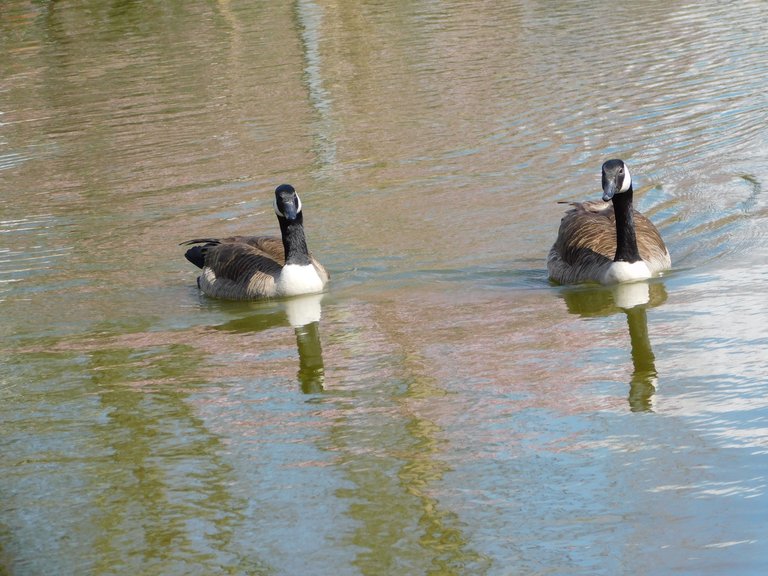
Image credit: agmoore
This blog was inspired by a peaceful walk on a lovely afternoon. The pond looked like a harmonious environment. I'm sure there was the drama of life and death going on under my nose. Isn't there always in nature? Winners and losers? But I won't let that thought ruin my impression of harmony. For one brief hour, on one sunny Sunday, the creatures of earth seemed to get along. Remarkably, none of them seemed to mind us, the humans.
Thank you for reading my blog. I hope you enjoyed the text and the pictures. All of these were taken with my camera, a little purple Nikon.

Turtle GIF: Turtle borrowed from the LMAC Image Library, LIL. Author: @muelli.
1https://www.beaumontenterprise.com/z-archived-entertainment/article/Red-eared-sliders-need-to-soak
2http://naturemappingfoundation.org/natmap/facts/red-eared_slider_712.html
3https://askanaturalist.com/who-is-eating-the-goslings/
4https://auduboninternational.org/wp-content/uploads/2019/03/WHM-Canada-Geese.pdf
5https://abcnews.go.com/Lifestyle/video/man-rescues-young-goose-turtle-attack-55665938
6
7https://www.dec.ny.gov/docs/administration_pdf/turtles2.pdf
8https://patch.com/new-york/kingspark/bp--all-about-long-island-turtles-natures-survivors
9https://www.pondboss.com/news/moderators-corner/to-aerate-or-not___is-it-really-a-question
10https://forgottenfriend.org/sliders/
11http://www.preservewildlife.com/canada-geese.html
12https://patch.com/new-york/kingspark/bp--turtles-dont-get-lost-people-do
13https://quoguewildliferefuge.org/news/creature-feature-eastern-box-turtle/
14https://www.turtleholic.com/midland-painted-turtle-profile/
15https://www.rspb.org.uk/birds-and-wildlife/wildlife-guides/bird-a-z/mallard/breeding/
16https://www.audubon.org/field-guide/bird/mallard
17https://www.turtlerescueofthehamptons.org/turtle-id/3296460
18https://www.allturtles.com/painted-turtle/
19https://fergusonmuseum.org/2014/06/nature-notes-fresh-water-turtles-of-fishers-island/
20http://www.turtlerescues.org/res.htm
21https://www.livescience.com/60054-animal-sex-red-eared-sliders.html
22https://www.geeserelief.com/geese-management/geese-breeding-season
23https://www.jsonline.com/story/communities/southwest/news/west-allis/2018/04/10/seven-things-you-never-knew-sex-lives/487046002/
24https://lakes.grace.edu/ponds-vs-lakes-whats-the-difference/
25https://esajournals.onlinelibrary.wiley.com/doi/full/10.1002/ecs2.3853
26https://www.dec.ny.gov/animals/34434.html
27https://www.nrcs.usda.gov/Internet/FSE_DOCUMENTS/nrcs141p2_018050.pdf
28https://farmfromhome.com/do-ducks-help-clean-ponds/
29https://creaseymahannaturepreserve.org/turtles-in-the-pond/
30https://magnoliafisheries.com/pond-turtles-good-or-bad/
31https://rangerplanet.com/do-mallard-ducks-mate-for-life-what-happens-and-timeline/
32https://www.biologyonline.com/articles/molecular-basis-of-temperature-dependent-gender-of-red-eared-slider-turtle
33https://www.encyclopedia.com/science/news-wires-white-papers-and-books/amniote-egg
34https://tpwd.texas.gov/huntwild/wild/species/slider/
35https://www.in.gov/dnr/fish-and-wildlife/hunting-and-trapping/canada-geese-management/behavior-and-biology/
36http://www.articles.lovecanadageese.com/lifemates.html
37https://www.easthamptonstar.com/archive/nature-notes-long-islands-ponds
38https://www.mentalfloss.com/article/76297/sort-bogus-reason-long-island-isnt-considered-island
39https://www.usgs.gov/centers/new-york-water-science-center/science/groundwater-sustainability-long-island-aquifer-system
40https://pubs.usgs.gov/wri/wri984069/pdf/wrir_98-4069_f.pdf)
41https://livestock.extension.wisc.edu/articles/the-origin-of-ducks/
42https://www.allaboutbirds.org/guide/Mallard/lifehistory
43http://nytts.org/nytts/NYS-ra-laws.htm
44https://www.wonderopolis.org/wonder/whats-the-difference-between-turtles-tortoises-and-terrapins
45https://petkeen.com/red-eared-slider-lifespan-how-long-do-they-live-captivity-wild/
46https://animals.net/painted-turtle/
47https://www.freep.com/story/news/local/michigan/2017/11/07/how-much-poop-can-one-canada-goose-poop-one-day-read/830375001/
48https://www.newyorkalmanack.com/2020/11/migrants-and-residents-canada-geese/
49https://www.dec.ny.gov/animals/7003.html
50https://www.dec.ny.gov/outdoor/28888.html
51https://www.humanesociety.org/sites/default/files/docs/canada-goose-guide.pdf
52https://www.sciencedirect.com/topics/engineering/anthropogenic-activity



Your publication looks like a nature magazine, if the sex of humans is determined by temperature just like in turtles, then now I understand why there are so many men with the heart of ice. 😄
I love the photos, you can see the harmony with which these animals live together, it must be relaxing to walk around that lagoon. Have a nice day my friend!🤗
😅
Thank you for visiting. You can see what a peaceful afternoon it was. So quiet. Hard to believe that just a quarter of a mile away there was one of the busiest thoroughfares on Long Island.
Have a wonderful day, dear @mballesteros 🌼🌼
🌻 🤗
What a beautiful creature.
This caught my attention. Many if not most animals get hugely affected by captivity one way or another, but the difference between 20 and 70 is remarkable.
Not only humans, but all life seems to yearn for freedom.
Thank you for that lovely read, and the wonderful pics @agmoore! 💚
Thank you for your visit and your kind comments. The nice thing about these pictures is, as I looked at them with my husband and read about them, we relived that afternoon. A moment in time. That's all there really is.
I agree about the turtles. I have mentioned in my blog before that I no longer visit zoos. Caged animals. No fun for them.
Hope you are having a peaceful day.
https://twitter.com/A_G_Moore/status/1516823694630346760
https://twitter.com/theycallmexois/status/1516826527509360645
The rewards earned on this comment will go directly to the person sharing the post on Twitter as long as they are registered with @poshtoken. Sign up at https://hiveposh.com.
I love seen black and white Canada geese in flight and moving in flocks with solidarity, it's beautiful lagoon view.
Amazing creatures👍
They are beautiful in flight, and noisy :) I love to hear them honking overhead when flocks migrate.
Thank you for visiting and commenting. Hope you have a great day.
Do you know that the giant tortoise lives at least a century and sometimes arrive at 200 years, it's amazing
Yes, they do live a long time. I was curious about their intelligence as researched this article. They have complex, adaptive brains. They are among the oldest species on earth. One turtles know how to do is survive.
Thanks for stopping by and commenting. Have a great day.
My city has all but declared war on the cobra chickens (aka Canada Geese). They're asking citizens to help identify nest sites throughout the city to prevent them from hatching so many eggs. They even nest on top of high rises. Swanky urban chic, if I may say so.
I'm also surprised how they generally coexist with other species, although I suspect they're specie-cists at heart. Let me explain. I saw a Canada Goose hanging out with a couple of ducks in a pond, having a good ole time and enjoying herself, when another ill-tempered goose showed up and chased the ducks away and said some mean things to the flirty Goose. It's like Days of our Lives down by the pond. ;)
I was also surprised (and delighted) by the harmony. After I got home I looked up the predatory behavior of the different animals. The geese are OK with plants and insects. The turtles and ducks however are hunters, especially the turtles. No wonder that goose kept an eye on the turtle. Large snapping turtles actually attack geese. They get snatch the geese from under the water. Goslings are especially vulnerable.
Canada geese are tenacious and messy, but I still love to look at them.
Thanks for visiting and commenting.
It always surprises me to see turtles maneuver so deftly underwater. I see the ducks and other birds like cormorants in the ocean, and they are amazing underwater swimmers. They ought to be considered aquatic creatures as well,
The geese love chilling in the ocean too. Here's a handsome fellow at sunset
It is quite interesting to see that most exotic species end up becoming invasive. WOuld be interesting to see the list of introduced plants/animals that do not outcompete native species once they can find their feet in their new environment.
This is quite refreshing and reeks of lessons in ecology. Thanks for sharing.
I did some hunting around and came up with this from a website called invasive.org:
"...only a small percent of introduced species ever become invasive. However, it is nearly impossible to predict which species will become invasive and new species are being introduced every day. Some species are present for many years before they exhibit invasive characteristics. Many invasive species go through a "lag phase" in which their populations grow slowly until they reach a size large enough for the population to explode and/or become adapted to the local environment and become invasive."
An interesting idea :)
Thanks for your visit and kind words. This blog was fun. I enjoyed learning about these quite familiar animals (although the red-eared slider was new to me).
I am currently living a very un-peaceful moment of my life, with so much work at the university that I am basically drowning. In this context, reading your blog was really relieving and relaxing (on top of providing ways to learn a few things about common animals from Long Island. Thanks a lot for this!
I am sorry about the lack of peace in your life. Drowning...oh no. Life intrudes. Don't fight it. Everything in its time. I don't know how you do it all...although once you did tell me you were an 'efficient' sleeper (means you cheat sleep, I think).
I really appreciate that you took the time to read my blog, given your schedule. Visiting the pond, learning about the animals, writing the blog: for me, all of it a source of peace.
Take care, @lemouth, and get enough sleep :)
Humans should be really thankful to the turtle boss, yea 😀
Ducks are like cleaners too @agmoore, they almost eat everything.
Great post, a refresher 😃
Thank you for stopping by. Yes, we should be grateful. I never realized that ducks and turtles clean ponds (sometimes!)
Have a great weekend.
Haha!
You too :)
Thanks for your contribution to the STEMsocial community. Feel free to join us on discord to get to know the rest of us!
Please consider delegating to the @stemsocial account (85% of the curation rewards are returned).
Thanks for including @stemsocial as a beneficiary, which gives you stronger support.
I am grateful, and honored. Thanks so much for the support and acknowledgement.
Lovely! Maybe you could shoot a short video next time!
Hello my friend, @alexanderalexis. Thank you for the visit and the positive appraisal.
Yes, a video. My granddaughter (😆!) has to teach me how to upload it.
Such a gr8 and informative post agmoore.
It always fascinates me how animals instinctively find their place in an ecosystem, even mini systems like a pond in a park, to the more predatory watering holes in the African savannah.
Each creature has it's place and regardless of the level of competitive predator/prey dynamic, without our (humankind) interference things stay in balance, even if cyclical the ecosystem will self correct.
Also, as a complete aside we get the canada geese visiting us too, and they can be seen usually landing on mass in Sefton park here in Liverpool. There aren't enough tho cause many problems though... of the poop variety 😂 They really do get around though.
Hello @raj808,
I know you are in tune with animals and nature. I'm glad you enjoyed this. I think it is evident that I did also. There was such balance on that afternoon. Even the couple of humans by the pond fit right in. Quiet and unobtrusive.
I'm glad you have Canada geese there. They are wonderful to look at. Just hop over the poop :))
Have a great weekend.
Excelentes imágenes e impresionante video. La descripción de los individuos y su relación ecológica es estupenda para comprender su papel en la naturaleza. Muy didáctico y recreativo. Saludos. aliriera